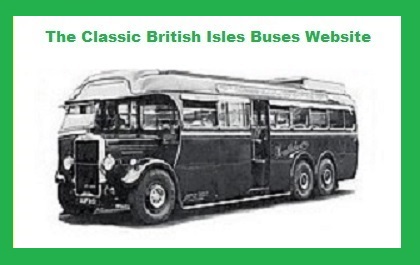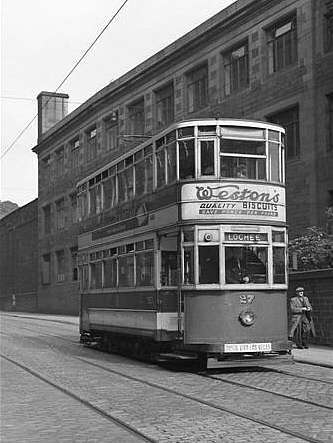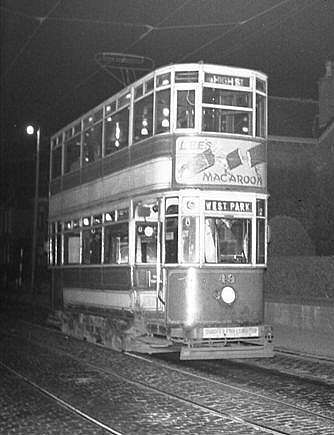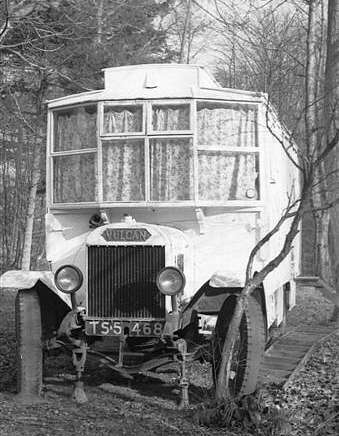

The Classic British Isles Buses Website
Dundee Corporation - miscellaneous (by Dick Gilbert)
Last updated 23 August 2024
Email Events diary Past events list Classified ads Links to other websites Classic U.K. Buses Classic Irish Buses Classic Manx Buses
| Photo collection | Pre-war double deckers | Post-war double deckers | Single deckers | Miscellaneous pictures |
This page is another collection of photographic contributions kindly supplied by George Bett, along with other images sent in by various photographers (all credited accordingly), with special thanks for John Hendy for his collection from 1973. Some of these photos were obtained by George Bett from other sources, including Dundee Corporation official pictures.
They show various bits and pieces that don't fit into any of the other categories in these Dundee pages. My thanks to George and all the others for this interesting collection. If you wish to make any comments, additions or corrections, please send them in.

Maryfield depot had originally been built for the trams, but by the mid 1950s trams were on their way out and the motorbuses took over the garage. Here, around 1957, we see new (and old) Daimlers under the overhead wires, with tramlines still in the cobbles, but already the trams themselves had gone. Maryfield depot has now been purchased by the Dundee Museum of Transport
Dundee Corporation Transport Department (DCT) traced its origins to a horse tramcar service in 1877, with steam trams following in 1887, and electrification shortly afterwards. After an experimental period of trolleybus operation from 1912 to 1914 (Scotland's first trolleybuses), motorbuses appeared in 1921 with four Thornycroft single deckers. Double deckers first appeared in 1931, and from 1935 the Corporation standardised on vehicles of AEC and Daimler manufacture only. This included the acquisition in 1955-56 of forty ex London Transport STLs and RTs, which were to replace the last trams in 1956. In 1961 Dundee became the first municipality to order significant deliveries of 36-foot single deckers (AEC Reliances). Dundee Corporation Transport was absorbed into the control of the new Scottish regions in 1975, and became Tayside Regional Transport, changing its livery from the familiar green to a striking blue and white.
My thanks again to George Bett for letting me use his unique collection of pictures.

Let's start with this wonderful picture. These tower wagons were conversions of two of the twenty Leyland PLSC1 Lions that were delivered to Dundee in 1927. To see one in its original state, click here. Wagon no. 1, on the left, was originally Dundee's very first Lion - fleet no. 1 (TS 6249) - while No.2 on the right had been no.18 (TS 7525). Retired and converted in 1934 and 1938 respectively, this dates the picture probably to the very late 1930s. Both survived in this duty until 1951. Their conversions to tower wagons indicates the necessity to maintain overhead wiring, and the reason for that was the trams - which takes us to the next picture.


Now I'm not going to dwell on the Dundee trams, because I know little about them, and anyway this is a classic buses website, but I can say that the Dundee electric tram system ran for about 60 years and closed on 27 October 1956, with the arrival of 10 London STLs and 30 RTs to replace them. On the left is tram No. 27 in Lochee Road, Dundee in 1955. It was built by Brush around 1930.
And on the right is No. 49 at Maryfield, advertising Lee's Macaroons. The picture was taken in 1956, its last year of service. So that's the end of the trams.

So let's return to the buses. This interesting picture shows the interior of AEC Q No.2 (YJ 2800), possibly taken when new in 1935. For a photo of the exterior of this revolutionary bus, click here. The big breakthrough with the AEC Q design was the relocation of the engine from the front to the centre, mounted largely under the floor on the offside. This had several advantages, the major one being that the entire area of the bus could be used for passengers (plus the driver, of course).
An unexpected benefit for the passenger was that on cold days (and there must have been many of those in Dundee), they had the chance to sit on the lengthwise bench seat visible on the right hand side of this picture. Under that was the engine, so the seat was always warm!

This picture is not from George Bett, but was kindly sent by Iain Farquhar. He says he is fairly certain he took it in May 1965 from 38 Kingennie Terrace, where he lived for 10 years as a 9-19 year old. The dramatic sky frames tree-lopper and driver trainer YJ 2792, a 1936 Daimler COG6 which had been no. 65 in service. George Bett took a picture of this same service vehicle in the 1950s (click here to view), but this photo, taken a year before it was finally retired, shows it in the later all-over green livery, yet still sporting the same dents and scrapes! Thank you to Iain for the photo, which leads us on to the picture below:

This picture from 1973, kindly sent in by John Hendy, shows what became the replacement for YJ 2792 above. Cut back in 1970 to create a tree-lopper as well as driver trainer T1, former no. 40 (YJ 9044) - a 1947 Daimler CVD6 - was eventually sold to a dealer (presumably for scrapping) in 1975. In the background is Croft-bodied Daimler CVD6 BTS 472 (former no. 132) which was driver trainer T3 from 1972 to 1976.

Here's the second bus from the set of trainers - T2, also from the lens of John Hendy in 1973. 1951 Daimler CVD6 (AYJ 378, former no. 126) with a Croft body, was relegated to learner duties in 1972 and withdrawn in 1975 due to accident damage. Presumably somebody wasn't learning very well.

And finally here is Daimler CVD6 trainer T3 (BTS 472, formerly no. 132) in 1973. Another fine photo by John Hendy.

Returning to George Bett's photos again, this picture probably shows one of the 1951 Croft-bodied Daimler CVD6s under construction. This was the batch of ten (fleet numbers 125-134) that included AYJ and BTS-registered vehicles. Maybe a reader can throw some more light on the subject.

In the mid 1950s we see an AEC Regent, clearly in distress, been towed along Dock Street, Dundee by the Corporation's breakdown tender. The bus would seem to be one of the four 1938 Weymann-bodied examples, which were coming to the end of their working lives by that time. The tender itself was apparently a Leyland, and George felt it could have Fire Brigade origins. Iain Drummond told me it was previously registered TS 9841, which would date it to a surprisingly ancient 1932.
Mr. B. S. Baxter, technical historian at the REME museum of technology has kindly supplied the following additional details: "The recovery vehicle appears to be an early 1930s Leyland Terrier. This was the normal control predecessor to the more common Leyland Retriever. The army had some Terriers and this could be an ex-army vehicle modified for recovery, although it doesn't appear to have a crane, and may be simply a towing vehicle. However some Terrier-based trucks were sold direct to the civilian market. Notable examples on this chassis were fire and rescue trucks for the Northumberland mines rescue service."
"The chassis was 6x4, i.e. drive to the two rear axles. Tyres were probably about 700 x 20 or civilian equivalent as the rear wheels are twinned. The vehicle in your picture seems to have a longer bonnet than some army Terriers and may have had a six cylinder engine. The military vehicles had canvas topped cabs but the bus recovery vehicle has the standard civilian cab as used on the four wheeled Beavers and Bisons of that period. Some odd Leylands were built using various standard components from a variety of more common types."
However, Iain Drummond told me: "I have been looking for some notes I made half a century ago reference the truck. It is a Leyland Hippo and the registration would be about right for the model of about 1932. This was about the time that Dundee started to buy Leyland double deckers. The transport committee probably thought that they would need a substantial truck to tow these home if they broke down on the Monifieth run. The truck would also have been very useful in towing failed trams."
And Mark Loudon kindly emailed to say that he is not sure that it was previously TS 9841 at all. "You have a picture of a recovery tow lorry, in which the description mentions a possible fire brigade link and a previous registration of TS 9841. If this is the case, it was bought in May 1932 by Dundee fire brigade, and was a Leyland Terrier type TE5 chassis no. 655. However TS 9841 was originally built as a fire engine with an open cab, a mid-mounted pump with the deliveries on each side just behind the front seat. The rear bodywork was of the new world type which is where the rest of the fire crew enter the bodywork from the back, and sit facing each other, and the ladder was down the driver's side of the appliance. So, if the vehicle you have pictured is TS 9841, then it has had by this time a full body rebuild with the fitting of a period Terrier cab of the 1930s."
David Craig adds: "The Leyland breakdown tender is an interesting vehicle. Comparing a photograph of TS 9841 (the fire engine) and the breakdown tender, it is not hard to imagine that the latter could have been an adaption of the former. If it was indeed TS 9841 then this was the vehicle that carried the coffin of Captain James S. Weir, the legendary firemaster of Dundee fire brigade from 1903 until his death in office in 1937, in his funeral procession from the central fire station to Balgay cemetary."
March 2016 update: and here it is!

Andy Sherrington's grandfather gave him a bunch of photos about 1979 and TS 9841 was among them. He said: "The photo is one of about a dozen I have of different fire engines built by Leyland Motors. They then went to the Chorley factory to have the bodies built and fitted. I think they are all publicity photos because they were taken in the same location (Pilling Lane, Chorley) just a few hundred yards from the factory - now houses! My grandad worked in the carpenter's shop on buses and coaches (and presumably fire engines)."
Thanks very much Andy. Now we have the complete story!

As mentioned above, the trams were withdrawn in 1956 and replaced by 40 retired London buses. At first this was not too popular with the folk of Dundee, who were uneasy about the use of second-hand vehicles for the first time. In order to reassure them, the first London Transport RT to be repainted was displayed in City Square so that the public could inspect it. Here we see no. 212 (JXC 178), previously London RT1415, being peered at in 1956. It even has its bonnet open, so presumably the engine bay was a source of pride for DCT as well as the rest of the bus.
In fact these buses were only seven years old at the time, and would prove to be perfectly adequate in their further twelve years of Dundee service.

By 1956 Daimler COG6 No.157 (YJ 4121) was twenty years old, and the entire batch (originally numbered 70-80, YJ 4115-4125) was being withdrawn. Not only were they pretty dated, but they looked it too, with the sloped front of the Cowieson body reflecting a style that had long been out of fashion. Here we see the remains of 157 at Marchbanks, Dundee, probably in 1956.

From the same batch as No.157 above, we see another 1936 Daimler COG6 in use at Logan's construction site during the building of the Tay Road Bridge in 1964. The styling of the Cowieson bodywork is unmistakable, despite some bizarre cosmetic modifications by its new owner. It's not possible to say exactly which bus this is, but I can tell you that the bridge was opened in 1966.

What's wrong with this picture? 1953 AEC Regent III No.136 has just been overhauled and repainted in 1957, only to emerge ex-works at Shore Terrace with the registration number incorrectly painted. It should read CYJ 251, but a dyslexic coachpainter has managed to change that.
But it's not surprising things got confused, considering all the number changing that went on. David Craig wrote: "Noting your confusion over Dundee Corporation's fixation with renumbering, I couldn't resist sending you a copy of a note that was added to a 1953 Dundee Corporation Transport fleet list held at Dundee City Archives."
"The arrival of 70-79 (CTS 629-638) called for the renumbering of the remaining Cowieson bodied Daimler COG6s 70, 71, 75, 76 to 154-157. Arrival of 135-141 (CYJ 250-256) meant that some of the Barnard bodied AECs (138-146) had to be renumbered. 138-141 became 150-153 which in turn meant that the existing 150-153 (YJ 7956 etc.) also had to be renumbered! They became 80-83. There were buses occupying these numbers too and so 81-83 (YJ 8105 etc.) became 112-114 and, to accommodate this change, existing 112-114 (YJ 2791-3) were renumbered 158-160 although in the event they were withdrawn along with 135-137 (YJ 2794-96) when the new vehicles entered service."
"I think someone at D.C.T. was having a laugh!"

Snow is, of course, an ever-present problem in Scotland, and the Dundee vehicles had their fair share of headaches. Here we see no less than FOUR single deck Daimlers stuck on Infirmary Brae on 8 February 1958. In the foreground is no. 12 (BTS 492), one of the Brush-bodied 1951 Daimler CVD6s. George, it seems, was never afraid to go out with his camera, whatever the weather.

And here is the same bus photographed in 1973 by John Hendy after conversion to a breakdown vehicle.

By 1963 the halfcab era was pretty well over, and Dundee was looking at the new rear-engined buses to update its fleet. It was not surprising that their regular supplier Daimler should be front-runner in this competition, and here we see Daimler Fleetline demonstrator 4559 VC under test on 6 May 1963 at Broughty Ferry, Dundee. This was clearly a successful trial, as the first of many Fleetlines were to start joining the fleet the following year.

There may be those amongst you who feel that my double decker fleet list on the other Dundee pages stops too soon, i.e. at the end of the halfcab era around 1960. That's often the way it works on this website, but just to show I'm not a complete bigot, here is a photo of Daimler Fleetline No.51 (CYJ 851D) taken at East Dock Street depot on 9 April 1975. It was one of twenty delivered in 1966, numbered 35-54 (CYJ 835-854D).
Malcolm McCrow notes: "It may be worth pointing out that the other Daimler just visible in this photo is sporting the final DCT livery of two-tone green which, in my opinion, was very attractive - the overall single green had been deemed by many to be too bland. It had been introduced as a cost saving measure and the later addition of dark green to the lower deck (or below the windows on single deckers) was something of a compromise."
Peter Marshall says that the two-tone green which Malcolm refers to above, was applied to one-man operated buses. He says these were always a bone of contention with Dundee crews.

Finally, I couldn't resist this one, despite it not being a DCT bus. This Vulcan was photographed by George in a wood north of Dundee in the late 1950s. The Dundee registration number TS 5468 would probably date from 1926 or early 1927. I love the bay window at the front, and wonder if anyone knows the history of this little gem. Is it a Vulcan Duchess?
Iain Drummond added the following comment: "The shot of the Vulcan is an interesting one. It is about a 1926 model, VWD or VWT. The named models were introduced after 1928 and this one is too early for that. The body looks very tram like and it has wire wheels. Of course it could be a caravan built in the 1930s on an old truck or bus chassis."
But Martin Ingle can go one better than that. He says: "TS 5468 was a Vulcan VSD new in December 1925, and is alive and well!! Keith Jenkinson's book on preserved lorries lists it as originally an ambulance but given a drop-side lorry body in its preserved state with Fairmuir School, Dundee."
And I received a message in October 2005 which said "This Vulcan lorry is now restored and owned by Andrew Cook and Sons of Leven, Fife. It is a 1925 Vulcan VSC".
In July 2009 I received the following message and photo from Ron Gray: "A friend who knew I had at one time owned a Vulcan directed me to your site. I can confirm that I bought the Vulcan in the photo from the manager of a music shop in Dundee Nethergate (Forbes?) in the spring of 1968, in the condition you see in the picture."

"At that time I lived in Carnoustie, and after some initial freeing off of wheels etc. the Vulcan was towed there by a local contractor. I removed the caravan body and started to build a cab and flat platform body. The attached photo was taken by the local Carnoustie paper dated 10 August 1968 and shows work in progress. Unfortunately due to a move south in early 1972 I sold the Vulcan on to Andrew Cook of Leven. Apologies for poor quality of the scanned photo, but I have the original newspaper article and picture."
Well, well! Thanks Ron. Isn't the Internet a wonderful thing? Does anyone have a recent picture of it?
Yes they do! Bob Weir sent the following in March 2010: "You mentioned you were on the lookout for a recent photo of Andrew Cook's Vulcan VSC. I have already featured the lorry in a 3-page article in Heritage Commercials magazine, and it should shortly be making a cameo appearance in a classic and vintage commercials feature about the Cook family's vintage fleet. I am currently finishing off another TS 5468 piece for Vintage Spirit magazine, which will probably be published later in the year. I found your recent update about previous owner Ron Grey to be particularly helpful."

And here is Andrew Cook standing proudly by his wonderful truck. Many thanks for the picture Bob.
Email Events diary Past events list Classified ads Links to other websites Classic U.K. Buses Classic Irish Buses Classic Manx Buses